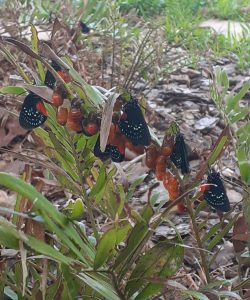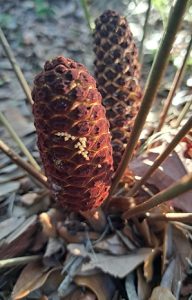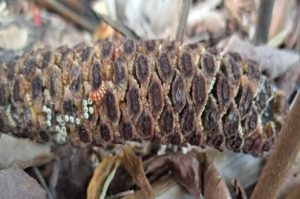Coontie Plant Care
South Florida’s Wet and Dry Seasons:
Coonties start to flush out new growth with warming temperatures in March through May and continue to do so during our rainy season, which runs June through September. Each plant will vary, some flush out once and others two or three times. Afterward the new growth slows down or stops and the plant switches gears to produce its male or female seed pods. The coonties appear to be resting from all this productivity from October to February. 
Established Atala colonies are active during this time, but at a much-reduced volume. They are their busiest in the spring and summer months when they lay their eggs on soft succulent new leaves. The caterpillars’ eating frenzy is at its peak. Whereas, in our dry season, they lay their eggs on older, hardened leaves. These caterpillars have no choice but to eat what is available even though they prefer tender new growth. During these lean months, I worry it may be my garden’s last year-round colony. They continue to surprise me and pull through! I purposely do not apply any extra watering during this time to let the plants rest.
The Hail Mary Pass:
 It is during these lean times that I notice the Atalas laying eggs on the coontie seed pods. This past winter, I witnessed some of the eggs on the pods develop into caterpillars. I do not know how far along they got as they either moved away from that spot or perished. I find this Atala behavior, to borrow a football expression, as their Hail Mary pass. A last-ditch effort to foster the next generation.
It is during these lean times that I notice the Atalas laying eggs on the coontie seed pods. This past winter, I witnessed some of the eggs on the pods develop into caterpillars. I do not know how far along they got as they either moved away from that spot or perished. I find this Atala behavior, to borrow a football expression, as their Hail Mary pass. A last-ditch effort to foster the next generation.
The coontie is a hardy plant, but it can succumb to environmental stressors. As butterfly gardeners we may overlook or forget that caterpillars stress the plants. It is a good idea to keep an eye on the coonties’ overall health and stay on top of the weeds. Pinch out and remove weeds that grow around its crown, crowding the plant’s ability to grow healthy. Waiting until the weeds take over makes it harder on you and them. 
Scales and Mealy Bugs:
Check the underside of the leaves for scales and mealy bugs. These insects are easily squished without hurting the plant. The earlier these insects are detected and addressed the better. I nip potential plagues with a combination of controls, such as manual squishing, water rinsing infected stems, and disposing of super infected stems. In worst-case scenarios I spray the plant with insecticidal soap. The UF/IFAS articles listed below address the scale and mealy bug issues and the use of insecticidal soaps. Throw out mulch and ground debris with powdery white matter that is part of the infestation. Keep the plant as healthy as possible. I have not come across eggs or caterpillars on coonties with scales or mealy bugs infestation. The Atala spends a lot of time scouting where to lay its eggs, they most likely avoid doing so on infected plants.
(UF/IFAS Extension: Natural Products for Managing Landscape and Garden Pests in Florida, Matthew A Borden, Eileen A. Buss, Sydney G. Park Brown, and Adam G. Dale)
(UF/IFAS Extension: Florida Coonties and Atala Butterflies, Daniel F. Culbert)
 3
3
